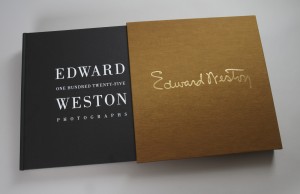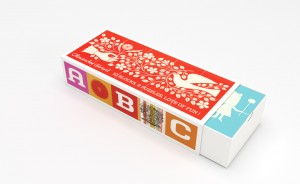On campus, Gloria Fowler ‘87 may be best known as a beloved Environmental Design instructor who has taught at the College for the last 20 years, helping students explore their creative potential. But equally impressive is her work off-campus, where she runs the thriving boutique art-house publishing company AMMO Books with her photographer-turned-publisher husband, Steve Crist, and business partner Paul Norton.
Launching a specialty book business is a risky venture, even more so in today’s age of declining book sales. But AMMO, which is based in Pasadena and Santa Barbara, Calif., has succeeded where others haven’t, publishing a number of coveted titles including the limited edition monographs Gonzo and Charley Harper, mid-priced options like Locals Only and Spike Lee: Do the Right Thing and a children’s line of board books, puzzles and more. Enviable press coverage and robust sales have followed.
The Dotted Line recently sat down with Fowler to discuss several new AMMO releases just in time for the holidays, as well as her experience running AMMO and working with emerging talent straight from the studios of Art Center.
Is there a story behind the name, AMMO?
When Steve and I decided to break out on our own and launch a new publishing house [he previously worked as a photo editor at Taschen], we realized that there weren’t that many visual-arts publishers based in the U.S. We also wanted to celebrate American artists and designers. So we came up with AMMO, which is short for American Modern Books. But we do publish international artists/designers as well.
What’s new at AMMO this holiday season?
We recently published a limited edition, coffee-table size monograph on the photographer Edward Weston in celebration of his 125th birthday. Weston is a hero of Steve’s and one of the most important photographers of the 20th century. Steve worked with the Center for Creative Photography in Arizona, which manages Weston’s archive, to choose 125 of Weston’s most iconic photographs. The book was beautifully printed in Italy and comes in an exquisite European gold cloth slipcase. Then we have Alexander Girard, edited by Todd Oldham. Girard was a seminal and prolific midcentury designer who produced work in so many disciplines—textiles, typography, graphics, illustration, furniture and architecture. He was a contemporary of Eames who, for whatever reason, hasn’t received the same recognition. We hope this book will change that. It’s massive—672 pages and 15 lbs(!)—and it’s at the level of Charley Harper in that the book is a very comprehensive overview of Girard. And in conjunction, we’ve released some children’s products featuring Girard’s designs—a memory game, giant floor puzzles, a board book and more on the way.
Catch a glimpse of the new Girard book here:
These aren’t the first children’s products developed by AMMO. How did AMMO get into this area?
I came up with the idea of creating a line of children’s products with the publication of Charley Harper. That book was really well received, and I had a feeling his simple, graphic, and colorful designs would translate well into children’s products. As the mother of two young children, I had turned into quite the savvy shopper, and I realized the limitations of what’s out there in the children’s market. So with Harper we saw an opportunity to create children’s products that could be beautiful, sophisticated and affordable while promoting great art and design. Plus I had a great testing ground at home with my own children. This is really my main area of concentration, and I’m looking forward to its continued growth.
Tell me about Gonzo, AMMO’s debut title.
Gonzo meant a lot to us personally. The author, Hunter S. Thompson, was known as the father of gonzo journalism. It’s basically a visual scrapbook of his life, a celebration of this unique, eccentric voice in American culture with a foreword by Johnny Depp. My husband, Steve, knew Hunter very well, and collaborated with him on the project prior to Hunter’s untimely death. We continued the project and published the book in December 2006, which coincided with a lot of press and retrospectives on Hunter. We then had a gallery show in West Hollywood at M + B Gallery, as well as one in London at Michael Hoppen Gallery that showcased a lot of Hunter’s photographs that he had taken in the ‘60s.
You’ve collaborated with the famed designer Todd [Oldham] on multiple AMMO projects. What’s that like?
My husband, Steve, met Todd prior to AMMO and realized immediately that he’s a kindred spirit. Todd has very similar interests and is also enthusiastic about celebrating his design heroes. Todd had been working on the Charley Harper book since 2001, or about five years before AMMO got involved. Once we were on board, Steve and Todd had the good fortune of presenting the first prototype of the book to Charley while he was in the hospital. He passed away within a week of seeing the book.
Wow, so the subjects of your first two books passed away before publication. That’s pretty intense.
Yes, we don’t wish to repeat that aspect of those experiences, which were otherwise quite wonderful.
How did you begin working with Patrick Hruby, the Art Center alumnus who has created a line of children’s products for AMMO?
About a year ago, during senior show, I was completely taken aback by Patrick’s beautiful, graphic and colorful wall-sized mural in the student gallery, titled: Imagine Something Beautiful. I introduced myself on the spot, and literally the Monday after his graduation called him into our studio to sign him up to create a new line of children’s books and products for us!
To date, Patrick has illustrated and together we have designed five books/products including ABC is for Circus, the Imaginary Castle giant floor puzzle, Natural Wonders coloring book, a memory game and Counting in the Garden (as featured in the latest issue of Dot magazine).
Coincidentally, when Patrick was a student, we arranged for Todd [Oldham] to speak in the Ahmanson and Patrick cites that experience as something that really influenced his style. I love when these connections happen between AMMO and Art Center.
Has AMMO worked with any other Art Center alumni?
Yes, we’ve also worked with Sun Young Yoo, who created exquisite ink drawings to illustrate a children’s book called The Red Shoes, that I adapted from the Hans Christian Andersen story. Like Patrick Hruby, I discovered Sun Young’s beautiful work on display in the hallways of Art Center and knew that I wanted to create a book with her. You never know what incredible talent you may find here!
As a small, boutique publisher, what’s your distribution strategy?
We definitely have a sense when we’re creating a product of where it should land. That knowledge up-front is so important. We’re fortunate because a diverse range of retailers carry our titles—chain bookstores like Barnes & Noble, independent book stores, museum gift shops, Old Navy, Urban Outfitters, Anthropologie and then boutiques like Marc Jacobs, Paul Smith, and Barney’s. In Spring 2012, Target will begin carrying a line of our books based on Kid Made Modern, as well as a line of D-I-Y crafts all designed by Todd Oldham.
Is that unusual for upscale boutiques to carry the same merchandise as big-box retailers?
Yes, I find it wonderful that high-end retailers like Marc Jacobs and Paul Smith carry some of our same children’s titles that first appeared at Old Navy. I love that high-low crossover; the idea of high design at really affordable prices and having it be accessible to so many diverse customers. We are fortunate that our children’s books and products have met with such universal appeal.
And Amazon?
Oh yes, Amazon is an important retailer for us. However, we still love the independent bookstores that have supported us all along, especially places like Pasadena’s own Vroman’s bookstore.
What are some of the challenges you’ve faced with AMMO?
We’ve had to balance doing projects that reflect our own personal interests that aren’t necessarily super profitable with those that can find success in the marketplace. We’ve published some labors of love that haven’t done as well as we would like, and that’s a risk we take. To survive, we need our books to cross over, to appeal to a broader market. The Harper projects were a great instance of that—designers, illustrators and animators love his work. At the same time, there’s a grandmother in Des Moines who is charmed by his illustrations of birds, or a three-year-old who can connect with his ABC books. This kind of singular talent doesn’t come around too often, but we’ve seemed to have good instincts overall so far.
What’s in the pipeline at AMMO?
We’re huge Eames fans, and we’re working with the Eames office and his grandson, Eames Demetrios [who has spoken at Art Center] on some great new projects that I can’t speak of just yet. We’re also looking into the creation of apps, especially for some of our children’s titles—I think they would translate well. More and more we see four- years-olds playing on the iPad.
Does this mean electronic books are on the horizon too?
The iPad is amazing, of course, but there’s no comparison to seeing something electronically on a glass surface versus the tactility of seeing a large format book that you can physically flip through. Some books and projects, particularly the children’s ones, lend themselves more to this new format than others.
That doesn’t mean we’re not cognizant of the decreasing market for printed books in general. Fortunately, we haven’t been as affected as publishers of literature. We can’t ignore the trend, but still we are pretty confident that people will continue to want to see fine art and design books at a large scale and in a physical form, and that they won’t soon become obsolete.
You’ve taught in Art Center’s Environmental Design Department for 20 years. What are you teaching this term?
I currently teach the Portfolio and Presentation class, helping students put together their graduation show for Environmental Design. This is such a great class and experience for our students because they get to design, build and install their own exhibit design showcasing their own work. Our students are well versed in so many areas, from the design of spaces to furniture, lighting and graphics. I may be partial, but I think we have the most Interesting and multidisciplinary major on campus.
You should come see for yourself this Saturday, December 17, in Room 225, following graduation!












